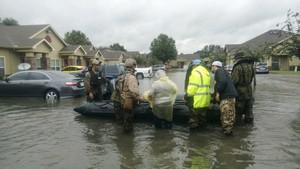Disaster preparednessIs Texas leading on disaster preparedness? Yes and no, experts say
During the first legislative session since Hurricane Harvey, state lawmakers are poised to make an investment in storm recovery and flood mitigation that some have described as unprecedented. But it’s more complicated than that.

Marines aid in search and rescue of hurricane vicitims // Source: dodlive.mil
More than a year and a half after Hurricane Harvey slammed into Texas, killing dozens, the state is still waiting on billions in federal recovery dollars. In the meantime, Texas lawmakers are looking to prepare the state — the most disaster-prone in the nation — for future storms.
During their first session since Harvey — a close second to Hurricane Katrina on the list of costliest tropical cyclones in U.S. history — legislators have filed dozens of bills this year aimed at storm recovery, response and preparedness. And they appear poised to withdraw billions from Texas’ historically flush emergency savings account to bankroll a variety of disaster-related items — measures that disaster response and flood control experts say are rare for any state, but especially historically frugal Texas.
Much of the money would go to school districts that saw sharp declines in property values and student enrollment after Harvey and to state agencies that diverted resources to respond to the storm. But most of it would go to help communities finance overdue flood control projects — and to help them secure billions more federal recovery and flood mitigation dollars.
Specifically, the legislation calls for the money to be funneled into a special account from which grants and low-interest loans would be doled out to communities for projects that may not be eligible for federal funding. It also would be used to help storm-battered communities pay for the so-called “local match” they must send to the federal government before it will release billions more dollars to repair storm-battered government facilities, and harden public and private structures so they can better withstand future storms.
